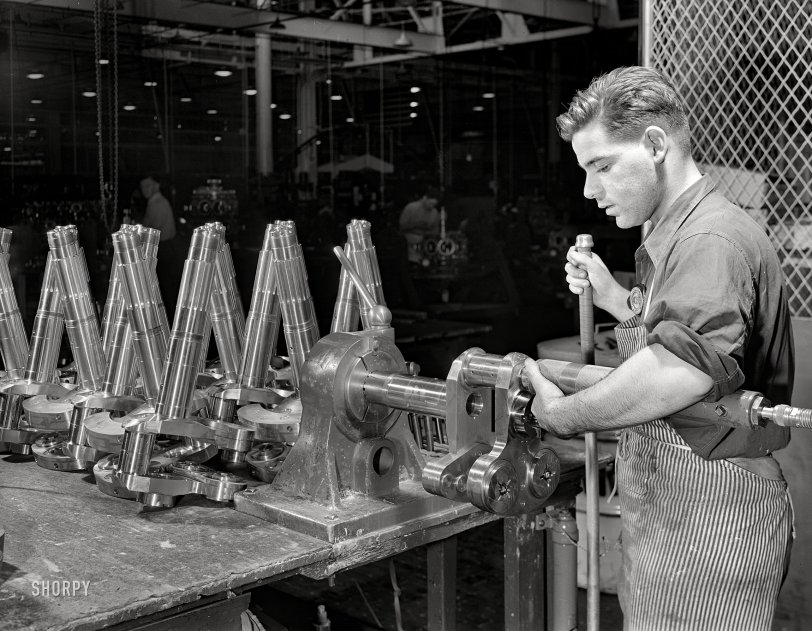


Framed or unframed, desk size to sofa size, printed by us in Arizona and Alabama since 2007. Explore now.
Shorpy is funded by you. Patreon contributors get an ad-free experience.
Learn more.

- Famous hollywood faces
- Not just S&P
- re: Those things in the jar
- Up In Smoke
- Medical Smoking
- Quick fix
- A Quink Comment
- If You’re Like Me, Never
- Delivering the News
- U.S.A.
- S&P
- 1940 Zenith radio model 6G601
- Quality goes in before the name goes on!
- Snazzy skirt
- Carbon Arc Lamps
- Illuminate us
- I remember it well
- I can't prove it
- Complicated then, forgotten now
- Bryan-Stevenson
- Skinny is as skinny does
- How do you rest in peace
- Riding the footboards
- Alas, hidden from view
- Baldwin Diesels
- Exclusive pump
- Bananas, Oysters and Smokey Joe
- Details, Details
- What's that building to the left of the tower?
- Coal Barges
Print Emporium
Air Power: 1942

June 1942. East Hartford, Connecticut. United Aircraft plant. "Single-row crankshaft assemblies for Pratt & Whitney airplane engines. The large Eastern plant at which the work is done is producing a steady flow of power installations for the fighting craft of our Army and Navy air forces." 4x5 inch nitrate negative by Andreas Feininger for the Office of War Information. View full size.
Patented crank halves fastening method
The Pratt & Whitney crank itself was only two forged pieces, with a very clever construction to hold them together after the one piece master connecting rod was slipped on one side. A clamp bolt held the two halves together but splines located each "half" in alignment. This fellow is doing something with the aforesaid clamp bolt or the machined cylindrical hole into which it fits. What exactly ain't entirely clear.
Explanation of parts here:
http://www.enginehistory.org/Piston/P&W/SingleRow/crank.jpg
The Shorpy photo is of a later design, but principles are the same.
Potato potato potato
The master / slave rod is also what gives old Harley Davidsons their distinctive sound
Pictures, I hope.
The multi-piece crankshaft and the whole idea of a master rod hooked up to the other eight are both conceptually simple and startlingly strange when you find out the secret.
I was fascinated when I first found out what the rod system looked like -- mainly, very different from my flathead Fords!
Pratt & Whitney Single-Row Radials

Oh no, the Master Rod!
The multi-piece nature of radial crankshafts has nothing to do with forging capabilities. Vastly larger forgings were easily available.
A radial engine crankshaft has only one crank per row, the master rod rides on it and all of the other cylinders' connecting rods are attached to the master. Because of its construction,the master rod has to be one piece, so the crank is made in several.
On multi-row engines (up to four) the crankshaft can be very complex indeed.
The Start --
Dad worked here during and right after high school in Norwich. This job experience led to enlisting in the Army Air Corps (6 Jan 1942, at Hartford). Subsequent training led to duty as a mechanic/crew chief on C-47's in the 13th Troop Carrier Squadron in the Pacific theater (Guadalcanal and Solomon Islands).
Pratt & Whitney's massive manpower and output expansion during this time frame was critical to the war effort.
Thanks for the photo. I like his "badge".
No forgery here
It looks like these crankshafts are made up of at least four different major components - the main shaft, the crankpin, and the two side plates. The young man is probably tightening the big bolt that holds the crankpin to the side plates. It looks like some of the counterweights or other fittings on the side plates may also be separate pieces.
At that time, some smaller crankshafts, like for an automobile engine, would have been forged. You have a gigantic press with very hard dies in it, you put a steel rod in that press, and operate the press - this makes all the major shapes in the crankshaft in one operation. You would still need to machine the bearing surfaces, flywheel/pulley ends, etc, but the basic shape is there from the beginning.
I don't know whether they simply couldn't forge a crankshaft this big in mid-1942, or they had the capability, but either they hadn't tooled up for this part yet, or they were using the forge for other part(s) that were considered more important or critical.
Even after the war, forging wasn't cheap. I have read (in Carroll Smith's "Engineer to Win") that as late as the mid-1960s, even race teams could not afford forging dies for racing engine crankshafts with small production runs; they had to start with a big block of steel and cut away everything that wasn't a crankshaft.
























On Shorpy:
Today’s Top 5